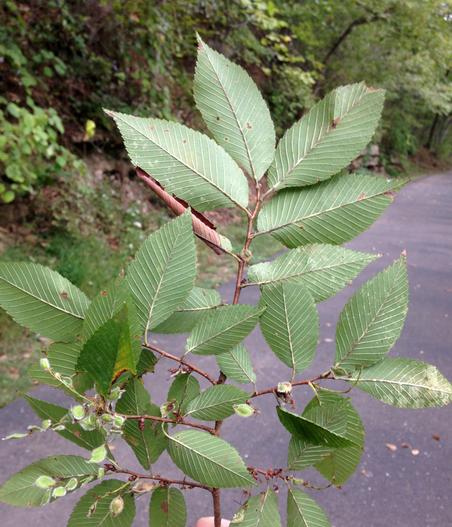September Elm
(Ulmus serotina)
September Elm (Ulmus serotina)
/
/

Mason Brock (Masebrock)
Public domain
Image By:
Mason Brock (Masebrock)
Recorded By:
Copyright:
Public domain
Copyright Notice:
Photo by: Mason Brock (Masebrock) | License Type: Public domain | License URL: https://creativecommons.org/public-domain/ | Uploader: Masebrock | Publisher: Wikipedia Commons













Estimated Native Range
Summary
Ulmus serotina, commonly known as September Elm, is a deciduous tree native to the limestone bluffs and riparian zones of the southeastern United States, with its range extending from Tennessee to various states including Illinois, Kentucky, Arkansas, Mississippi, Oklahoma, Alabama, Georgia, and also reaching into Nuevo León, Mexico. It thrives at elevations up to 1312 feet and is adapted to grow in well-drained soils along streams and rivers. September Elm typically grows to a height of 66 feet with a rounded crown and spreading branches, providing moderate shade.
September Elm is notable for its late-season flowering, producing inconspicuous wind-pollinated flowers in September followed by the ripening of samarae in November. While it was once a popular shade tree, its use has declined due to its high susceptibility to Dutch elm disease. In cultivation, it requires full sun to part shade and prefers moist, well-drained soils. It is not commonly used in urban planting due to disease issues, but it can be found in naturalized areas where its autumn flowering provides ecological interest. Gardeners should be aware of its vulnerability to Dutch elm disease and consider disease-resistant cultivars or alternative species for planting.CC BY-SA 4.0
September Elm is notable for its late-season flowering, producing inconspicuous wind-pollinated flowers in September followed by the ripening of samarae in November. While it was once a popular shade tree, its use has declined due to its high susceptibility to Dutch elm disease. In cultivation, it requires full sun to part shade and prefers moist, well-drained soils. It is not commonly used in urban planting due to disease issues, but it can be found in naturalized areas where its autumn flowering provides ecological interest. Gardeners should be aware of its vulnerability to Dutch elm disease and consider disease-resistant cultivars or alternative species for planting.CC BY-SA 4.0
Plant Description
- Plant Type: Tree
- Height: 60-80 feet
- Width: 30-40 feet
- Growth Rate: Moderate, Rapid
- Flower Color: N/A
- Flowering Season: Summer, Fall
- Leaf Retention: Deciduous
Growth Requirements
- Sun: Full Sun, Part Shade
- Water: Medium
- Drainage: Fast, Medium
Common Uses
Bird Garden, Low Maintenance
Natural Habitat
Native to limestone bluffs and riparian zones in the southeastern United States and Nuevo León, Mexico
Other Names
Common Names: Red Elm
Scientific Names: , Ulmus serotina, Ulmus divaricata, Ulmus multinervosa,
GBIF Accepted Name: